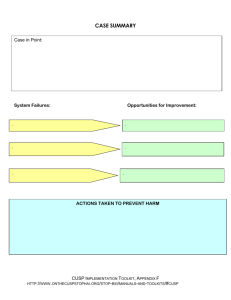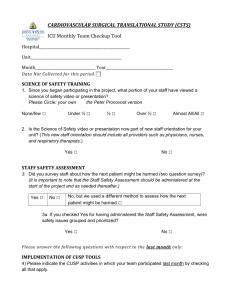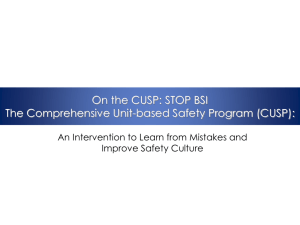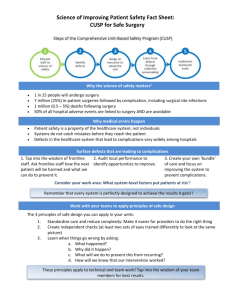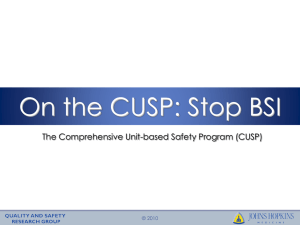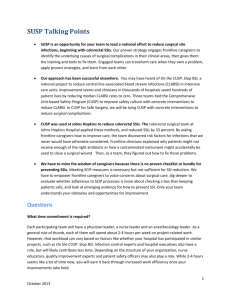File
advertisement
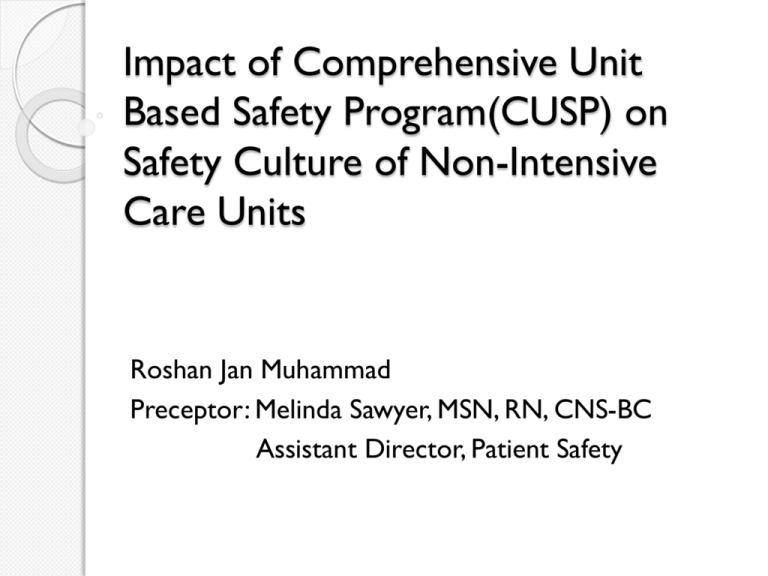
Impact of Comprehensive Unit Based Safety Program(CUSP) on Safety Culture of Non-Intensive Care Units Roshan Jan Muhammad Preceptor: Melinda Sawyer, MSN, RN, CNS-BC Assistant Director, Patient Safety Background 13.5% of hospitalized Medicare beneficiaries experience adverse events during their hospital stays that include hospital associated infection, medications errors, falls etc. Of which, 44% adverse events and related harm events are likely preventable. (DHHS, 2010) More than one third of patients who sustain hospital associated adverse events develop temporary or permanent disability and up to 20.8% of patients die. (Andres-Andres et al., 2009 & Zegers et al., 2009) Safety culture has emerged as an important factor that contributes to quality and safety of care provided and the clinical outcomes of patients in the hospital. (Pronovost et al., 2006; Kirwan et al., 2013;Watcher, 2008 , Singer et al., 2009; Mardon et al., 2010 & Sexton et al., 2006) Joint Commission and Institute of Medicine (IOM) committee requires health care organizations to measure and improve organization’s safety culture. (The Joint Commission, 2010,; Christine et al., 2010) Safety Culture and its Significance “Safety culture of the organization is the product of individual and group values, attitude, perceptions, competencies, and the patterns of behavior that determine the commitment to, and the style and proficiency of, an organization’s health and safety management” Work Environm ent Perception about manageme nt Safety climate Christine et al., 2010, Determines staffs compliance to policies Chaboyer, 2013 Facilitates professional practice, and error reporting Kirwan et al, 2013 Elements of a Safety Culture Job satisfactio n Stress recogniti on Measured by a valid instrument called “Safety Attitude Questionnaire (SAQ)” Motivates the engagement of the employees in safety behaviors and initiatives Team work Sexton et al, (2006) Predictor for number of medication errors reported Contributes to incidence of hospital associated pressure ulcer, falls, and infections Ausserhofer et al., 2013 Patient satisfaction index CUSP and Safety Culture: A Literature Review CUSP: A FIVE LEGGED PROGRAM Train staff in the science of safety Engage staff to identify the defects Partnership with senior executives Learn from defects Implement tools to improve communication CUSP RELATED CLINICAL OUTCOMES Wick, 2012; Hong, 2013 • Decreased (CLBSI, SSI) Pronovost et al., 2005 • Improved length of stay Pronovost et al., 2006 • Reduced mortality Simpson et al, 2011 • Improved stage II labor care Timmel et al, 2008 • Decrease nursing turnover Authors Settings and sample Team work Climate Safety Climate Job Satisfactio n Working Condition Perception of management Stress Recognition 62% vs 68% (p < .001) 45% vs 46% (p > .05) Pre vs Post CUSP scores Pronovost et al, 2005 2 surgical ICUs 35% vs 68% Pronovost et al, 2008 72 ICUs 46 % vs 50% (P < .005). Timmel et al, 2010 18 beds Surg unit 65% vs 71% (p < .001) Sexton et al, 2011 71 ICUs Vigoritto et al, 2011 23 adult (med/surg ICU’s, 11 hospitals 18.4% in IG vs 6.4% decline In CG (P <0.07) Simpson et al, 2011 Perinatal teams , 11 hospitals Saladino et al, 2013 Piane et al, 2013 61% vs 69% (p < .001) 61% vs 66% (p < .001) 48% vs 55% (p < .001) 7.5% in IG vs 3.4% in CG (P 0.78) 25.9% in IG vs 7.3% in CG (P<0.07) No Improvement No improvement No improvement 65th to 75th percentile 48th to the 69th percentile 36th to the 54th percentile Nominal improvement 22 bed CCU No improvement No improvement No improvement No improvement No improvement No improvement 144 clinical units > 10% or over 60% scores post CUSP > 10% or over 60% scores post CUSP 42% to 52 % (p < .001) Key: IG (Intervention group); CG (control group); med(medical); surg(surgical) 4.5% in IG vs 6.6% decline in CG (p 0.98) Problem Statement and Question Most of the CUSP successes are reported in intensive care settings. Johns Hopkins Hospital has replicated CUSP as a quality improvement measure in many non ICU units in over last few years to improve patient’s safety. The impact of CUSP in adult medical surgical units is not exclusively examined. This outcome analysis project aimed to assess if CUSP is associated with improvement in safety culture of adult/pediatric nonintensive care medical surgical units of Johns Hopkins Hospital. Method Design: retrospective cross sectional Setting: In-patient non-critical units at JHH. Inclusion Criteria o In-patient CUSP units o Implemented CUSP between 2006-2010 o SAQ results available before and after CUSP kick off Exclusion Criteria o Intensive care units o Units merged or split during 2006-2010 o Missing pre or post CUSP SAQ results Method • • • • Sample Size: Eight non-intensive care adult/pediatric in-patient units Data Collection and Database: o SAQ results retrieved from vendor based soft ware “Pascal Matrix” and excel reports. o CUSP kick off dates of units from quality departments. o Created a surrogate database on excel according to our project variables. Variables o Independent variable: CUSP o Dependent variables: Seven safety domains of SAQ Statistical Analysis: Paired t-test Results Descriptive Characteristics (n=8) Type of units (n,%) Adult Medical Adult Surgical Psych Peds Survey response rate % (mean, SD) Pre CUSP 5 (63) 1 (13) 1(13) 1(13) (n = 3) 76.99 (8.0) Post CUSP 5 (63) 1 (13) 1(13) 1(13) (n = 8) 81.86(15.79) Time from CUSP to SAQ survey in months (mean, SD) 13.38 (8.34) 20.75 (4.25) Unit specific Pre and Post CUSP Safety Attitude Questionnaire (SAQ) Results (%) Units Safety Culture Domain CUSP Status Peads Psych Adult Surgical 76 Adult Medical 1 50 Adult Medical 2 68 Adult Medical 3 88 Adult Medical 4 100 Adult Medical 5 70 Team work climate Pre 74 44 Post 73 66 43 80 74 96 100 84 Safety climate Pre 61 56 64 40 68 88 96 66 Post 71 61 50 69 72 81 96 76 Pre 67 48 56 40 70 88 90 58 Post 60 66 45 69 74 96 96 97 Pre 29 52 56 36 62 48 66 66 Post 33 46 58 46 62 67 67 63 Pre 49 40 52 50 64 75 72 38 Post 62 46 48 74 66 78 69 73 Perception of senior management Pre 31 26 30 36 58 61 76 30 Post 70 31 16 53 71 85 61 61 Perception of local management Pre 56 38 63 36 70 92 86 50 Post 78 67 47 72 81 73 87 72 Job satisfaction Stress recognition Working condition Mean (SD) 71.2 (18.2) 77.1 (17.9) 67.4 (17.6) 72.0 (13.7) 64.5 (17.8) 75.5 19.3) 51.8 (13.7) 55.1 (12.0) 55.0 (13.9) 64.4 (11.7) 43.6 (18.6) 56.0 (22.4) 61.2 (20.5) 72.0 (12.0) Comparison of Mean SAQ Scores of Eight Units Pre and Post CUSP (%) Safety Culture Domains Mean Positive score Pre CUSP Post CUSP Difference Mean SD Paired t test df p Team work climate 71.21% 77.15 -5.94% 18.84% -.893 7 .402 Safety climate 67.43% 72.07 -4.64% 12.66% -1.037 7 .334 Job satisfaction 64.58% 75.53% -10.94% 16.95% -1.826 7 .111 Stress recognition 51.82% 55.16% -3.34% 7.78% -1.213 7 .264 Working condition 55.02% 64.45% -9.43% 13.70% -1.948 7 .092 Perception of facility management 43.63% 56.01% -12.38% 19.65% -1.782 7 .118 Perception of local management 61.24% 72.02% -10.78% 20.29% -1.502 7 .177 Conclusion CUSP has shown statistically non-significant but clinically encouraging improvement in job satisfaction, perception of unit and senior management, team work climate, working condition and safety climate domains of safety culture of adult/pediatric non critical care units. Mean score on subscale of stress recognition stands lowest pre and post CUSP and showed a nominal increase from the baseline. These findings are unique as none of the research has reported CUSP successes in adult medical, psychiatric and pediatric non critical settings. Implications for Practice CUSP is an efficient model that can be utilized by non critical in-patient units to positively enhance working condition, teamwork climate, job satisfaction, safety climate of their units and to improve the perspective of staff about leadership. Organizations need to track other evidence based interventions to appreciate and improve on stress recognition domain of safety culture. Limitations Small sample size Convenient sample-----unequal representation from all departments Incomplete data (SD and sample size for unit level scores, responses by staff categories) Inadequate control over confounding variables Long term sustainability of the positive outcomes are not ascertained. CUSP is a bundle intervention, thus, could not determine which intervention works best for which domain of safety culture. Implications for Research Randomized control trial to establish a cause and effect relationship. Compare CUSP with other interventions that proclaims to improve safety culture. Longitudinal study that evaluates if CUSP is able sustain the safety culture scores. Identify and test interventions other than CUSP to improve the stress recognition domain of safety culture. References Aranaz-Andres, J.M., Aibar-Remon, C.,Vitaller-Burillo, J., Requena-Puche, J., Terol-Garcia, E., Kelley, E., Gea-Velazquez de Castro, M.T., group E.w., 2009. Impact and preventability of adverse events in Spanish public hospitals: results of the Spanish National Study of Adverse Events (ENEAS). International Journal for Quality in Health Care. 21 (6), 408–414. Ausserhofer, D., Schubert, M., Desmedt, M., et al. (2013). The association of patient safety climate and nurse-related organizational factors with selected patient outcomes: A cross sectional survey. International Journal of Nursing Studies. 50, 240-252. Chaboyer,W., Chamberlain, D., Thalib, L.,& et al. Safety culture in Australian intensive care units. Establishing a baseline for quality improvement. (2013). American Journal of Critical Care. 22(2), 93-102. Christine, E,. Sammer, Kristine, L., et al. (2010). What is patient safety culture? A review of the literature. Journal of Nursing Scholarship. 42(2), 156-165. Department of Health and Human Services (DHHS).(2010). Adverse Events in Hospitals: National Incidence Among Medicare Beneficiaries. Retrieved from https://oig.hhs.gov/oei/reports/oei-06-09-00090.pdf Hong, A.. L.., Melinda, D. S.., Andrew, S., Bradford, D. , et al. (2013). Decreasing Central-Line– Associated Bloodstream Infections in Connecticut Intensive Care Units. Journal of Health Care Quality. 35(5), 78-87. Mardon, R. E., Khanna, K., Sorra, J., Dyer, N.,& Famolaro,T. (2010). Exploring relationships between hospital patient safety culture and adverse events. Journal of Patient Safety. 6,226-32. References Morello, R. T., Lowthian, J. A., Barker, A. L., et al. (2013). Strategies for improving patient safety culture in hospitals: A systemic review. British Medical Journal of Quality and Safety. 22, 11-18 Paine, A. L., Rosenstein, B. J., Sexton, J.B., Kent, P., Holzmueller, C. G., & Pronovost, P. J. Assessing and improving safety culture throughout an academic medical center: A prospective cohort study. Quality and Safety of Health Care.19, 547-554. doi:10.1136/qshc.2009.039347 Kirwan, M., Mathews, A.,& Scott, A. (2013). The impact of work environment of nurses on patient safety outcomes. A multi-level modeling approach. International Journal of Nursing Studies. 50, 253-263. Pronovost, P. J., Berenholtz, S.M., Goeschel, C., Thom, I., Watson, S. R., Holzmueller, C. G., Lyon, J.S., Lubomski, L.H., Thompson, D. A. et al. (2008). Improving patient safety in intensive care units in Michigan. Journal of Critical Care. 23, 207–221 Pronovost, P., Needham, D., Berenholtz, S., et al. (2006). An intervention to decrease catheter-related bloodstream infections in the ICU. New England Journal of Medicine. 355, 2725-32. Pronovost, P. J., Weast, B., Rosenstein, B., et al. (2005). Implementing and validating a comprehensive unitbased safety program. Journal of Patient Safety. 1, 33-40. Saladino, L., Pickett, L. C., Frush, K., Mall, A.,& Champagne, M.T. (2013). Evaluation of a nurse-led safety program in a critical care unit. Journal of Nursing Care Quaity. . 28(2), 139–146. Sexton, J. B., Helmreich, R. L., Neilands, T. B., Rowan, K., et al. (2006).The safety attitudes questionnaire: Psychometric properties, benchmarking data, and emerging research. BMC Health Services Research. 6(44), 1-10. doi:10.1186/1472-6963-6-44 References Singer, S., Lin, S. Falwell, A., Gaba, D.,& Baker, L.(2009). Relationship of safety climate and safety performance in hospitals. Health Service Research. 44,399-421 Simpson, K.S., Knox, E., Martin,M., George,C.,& Watson, S.R.(2011). Michigan health & hospital association keystone obstetrics: A statewide collaborative for perinatal patient safety in Michigan. The Joint Commission Journal on Quality and Patient Safety. 37(12), 544-552. Timmel, J., Kent, P. S., Holzmueller, C. G, et al. (2010). Impact of the Comprehensive Unit-based Safety Program (CUSP) on safety culture in a surgical inpatient unit. The Joint Commission Journal of Quality and Patient Safety. 36, 252-60. The Joint Commission (2010). Behaviors That Undermine a Culture of Safety. Applicable Joint Commission Standards: Standard LD.03.01.01. Retrieved from http://www.jointcommission.org/NewsRoom/PressKits/Behaviors+that+Undermine+a+Culture +of+Safety/app_stds.htm. Vigorito, M.C., McNicoll, L., Adams, L.,& Sexton B.(2011). Improving safety culture results in Rhode Island ICUs: lessons learned from the development of action-oriented plans. Joint Commission Journal of Quality and Patient Safety. 37,509-14. Wachter, R.M.. (2008). Understanding Patient Safety. McGraw Hill Medical, New York Chicago San Francisco Weaver, S. J., Lubomksi, L. H., Wilson, R. F., et al. (2013). Promoting a culture of safety as a patient safety strategy. A systemic review. Annals of Internal Medicine. 158, 369-374.
